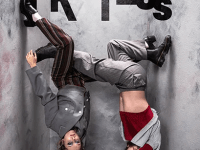 In previous articles, I have alluded to the effective utilisation of your mental and emotional focus in achieving your maximum performance, both on and off the floor. So, you may well be thinking “why affect … doesn’t he mean effect?”
In previous articles, I have alluded to the effective utilisation of your mental and emotional focus in achieving your maximum performance, both on and off the floor. So, you may well be thinking “why affect … doesn’t he mean effect?”
In every performance we are trying to have an effect on an audience, though to do this, we must affect their world in some way – ie take them to a place away from the here and now … to a world you have created for them … to a story that feels welcoming to them.
So, I am suggesting dancing is a means of affecting the current state an audience member is in at the time of your performance. To do this successfully is more than just performance – it is you dancing “inside out” – ie being able to show the world what you are feeling and experiencing … not an easy task … unless …
I want to talk briefly about what I believe is vital to an “honest” performance – body belief, partnering and connectivity. Let’s have a look at each in turn.
When I speak of body belief I am alluding to the association between what you are feeling on the inside and in your mind, and the story your body is telling the audience. It’s a bit like trying to tell a lie as a kid. Remember how our parents could always tell when we were “fibbing” – somehow, we thought we were making the story real, but they always saw the truth, because our body language, posture and positioning, as well as our facial expressions, seemed to convey what really was going on.
Same for dancing … Sounds easy, doesn’t it. However, this can be one of the hardest elements of a good performance to master, because we are fighting instincts and beliefs that “go back a long way”.
Is what you are projecting out to the audience what you
are seeing, feeling and believing inside.
This is where partnering comes into being. If dancing with a partner, you need to be conscious of each other and what each of you is conveying outwards. Remember, body belief is only the initial step in delivering your story to the audience. By making eye contact with your partner you are creating the next step by seeing into your partner’s mind and emotions – your eyes truly are “the portal into your very soul”. Communicating together through using your body is a further step in understanding / appreciating what your eyes are “saying”.
Imagine dancing with a partner, both blindfolded – you can reasonably successfully visualise how you are looking, but what about your partner. You know what you both practiced, but without “real contact” you become two rather than one in your performance; there is no opportunity for you to create together the magic of your belief in your dance, and your story.
Communicating emotion and belief through eyes, fingers and body …
together two becomes one, telling your story through a shared experience.
Remember the audience? Think back to a time when you watched someone dancing – what do you remember most – the steps used, or the illusion created. Did the dance take you somewhere, or did you simply enjoy the routine for its mechanical soundness. From my own experience, the dancers I remember the most are the ones that have touched my emotions and imagination just through their performance.
You see, unlike partnering, you don’t have to make direct eye contact with the audience to capture their interest and attention. If you are truly “in the moment” you will engage with and affect the audience through your own actions – what I like to call connectivity.
I remember recently watching a ballroom dancer in the middle of a routine during the recent Queensland Open. I don’t know if she was better than the others on the floor from a mechanical point of view – that’s for the judges to decide. What I did find, however, was a face so involved in the moment and so totally immersed in the pleasure of her dance that I was taken on a journey with her – she became the only person on the floor for me. Funnily enough, she and her partner were quite successful, as it turned out.
Unfortunately, I also discovered a large number of dancers who weren’t living the moment, and I felt no compulsion to engage with them.
You see, I am not qualified to be a dance critic – but I am qualified to know when someone is taking me on a journey, and one which I willingly want to be a part of. They have body belief, they partner with their fellow performers, and they connect to their audience by creating a world that is totally inviting.
Are you dancing to affect or simply dancing.
Greatness comes from a place much deeper inside than can be imagined, and will never be learned in a practice studio.
www.redriverjourney.com.au









